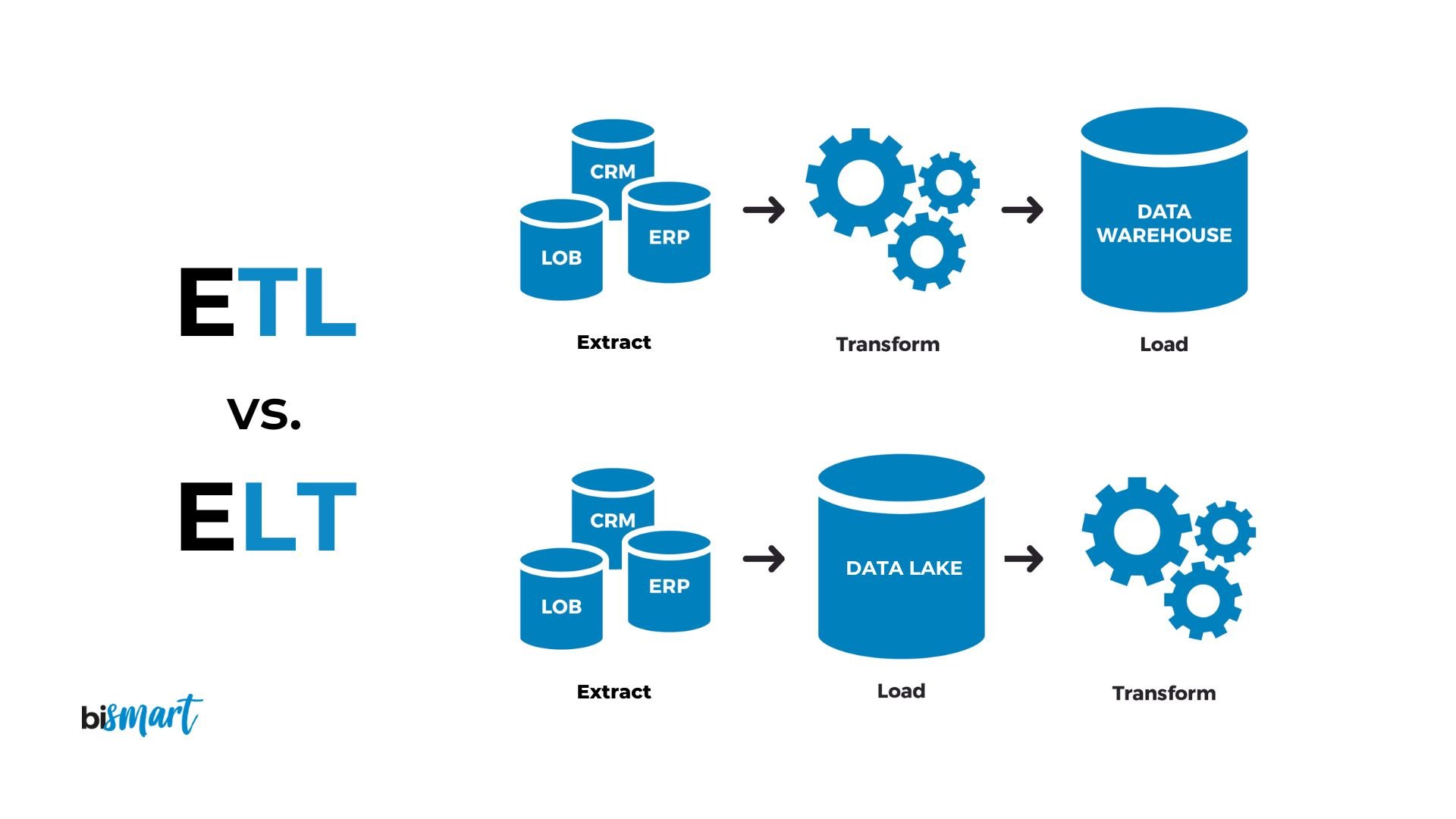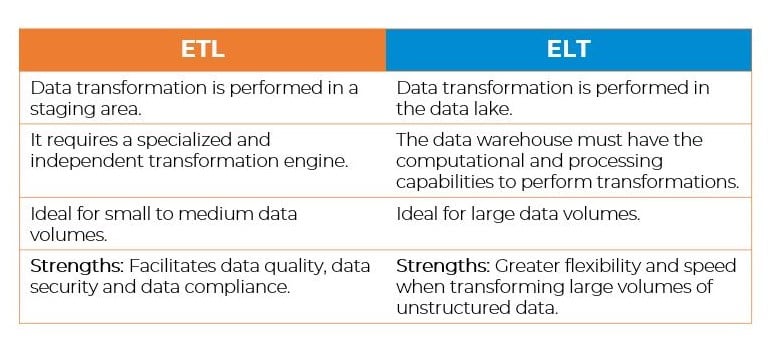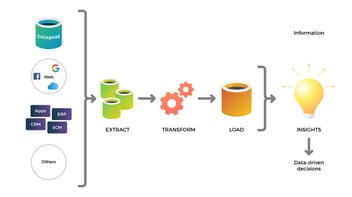ETL vs. ELT: Which process is more efficient? We explore the differences, advantages and use cases of ETL and ELT.
The ETL process has been main methodology for data integration processes for more than 50 years. However, recently a new approach, ELT, has emerged to address some of the limitations of ETL. Both processes have their advantages and disadvantages, but which is more efficient, ETL or ELT? In this article we explore the differences between ETL and ELT and their use cases.

ETL (Extract, Transform and Load) has been the most used methodology for carrying out data integration processes since the 1970s. However, new demands in terms of volume, velocity and variety in data management have led to the emergence of a new approach to the traditional ETL process: ELT.
ELT, Extract, Load & Transform, is an updated methodology for loading, storing and integrating data that reverses the usual order of transformation and loading in ETL.
In an ELT process data is extracted from the data sources, loaded directly into the data repository, a data lake, and then transformed as necessary within the data repository itself. This allows for real-time transformations and leverages the processing and storage capacity of the data lake for more efficient analysis and queries.
Both ELT (extract, load, transform) and ETL (extract, transform, load) transport raw data from a source system to a target database, typically a data lake or a data warehouse. These data sources may be in multiple repositories or in legacy systems that are then transferred via ELT or ETL to a target database.
What is ELT (Extract, Load and Transform)?
In an ELT process, unstructured data is extracted from a source system and loaded directly into a data lake for later transformation. Thus, unlike an ETL process, once extracted, the data is immediately made available to corporate business intelligence systems, without the need to prepare it for exploitation. This logic allows data analysts and data scientists to perform ad-hoc and on-demand transformations.
The loading of raw data into a data lake without the need for prior transformations speeds up the process, making greater speed one of the great advantages of ELT over ETL.
ELT is especially useful for basic data transformations, such as data validation or data de-duplication. These processes are updated in real time and are used for large amounts of raw data.
However, ELT is a fairly young process and therefore its technical development is still less advanced than that of an ETL process. Originally, the ELT process was based on coded SQL scripts which are more likely to contain coding errors than the more advanced methods used in ETL.
What is ETL (Extract, Transform and Load)?
In an ETL process, data is extracted from its source and the necessary transformations are performed to prepare the data for further use before loading it into the target system.
In a traditional ETL scenario, once extracted, unstructured data is loaded into a staging area where it is subjected to a transformation process that organises and cleans it, transforming it into structured data. This transformation process allows the now structured data to be compatible with the target data storage system, usually a data warehouse.
What is the main difference between ETL and ELT?
Si nos fijamos en sus siglas, puede parecer que la única diferencia entre ELT y ETL es el orden de las operaciones del proceso. No obstante, en este caso, el orden sí altera el producto.
Looking at their acronyms, it may seem that the only difference between ELT and ETL is the order of the operations in the process. However, in this case, the order does alter the product.
In practice, in ETL processes, it is common for data extraction, transformation and loading to be executed in parallel in order to speed up the process. Therefore, the main difference between ETL and ELT lies in the location of the data transformations and not so much in the order of the processes.
In an ETL process, transformations are performed during the transfer of data from multiple data sources into a single data warehouse or data mart. These transformations require a temporary data repository with a specialised engine for their execution. In contrast, in ELT, transformations take place in the back-end data lake, which eliminates the need for a separate transformation engine. The raw data is loaded directly into the target data repository, where data security measures must be applied.

What are the benefits of ELT compared to ETL and vice versa?
ELT's main advantage: higher speed
Without a doubt, the reason why more and more companies are opting for the ELT approach is the faster execution of the process.
Since data transformations are performed after the load function, the migration slowdown that can be experienced during an ETL process is avoided. On the other hand, ELT separates the transformation and load stages, preventing a coding error (or other error in the transformation stage) from stopping the data migration.
In short, the great advantage of ELT is that the speed of data ingestion is significantly faster than in ETL, as the process has a simpler architecture, does not involve heavy operations and avoids a crucial step in ETL: copying the data.
ETL's main advantage: increased security
ETL es un proceso algo más lento que ELT, ya que implica más pasos como la carga de los datos en un área de staging para realizar las transformaciones. No obstante, se trata de un proceso más seguro, que da como resultado datos más limpios y que es menos susceptible a contener errores de codificación en los datos.
ETL is a somewhat slower process than ELT, as it involves more steps such as loading the data into a staging area to perform the transformations. However, it is a more secure process, which results in cleaner data and is less susceptible to coding errors.
ETL provides a more secure way of performing data transformations, as they are conducted before the data is loaded into the target warehouse. Also, because ELT tools are designed for easy access to data by end users —they can be accessed from any data source via a URL— the security risk is higher than in an ETL process and data governance is more complex to ensure.
ETL also brings benefits in terms of compliance with data privacy regulations such as the GDPR. In an ELT process, sensitive data is more vulnerable to being stolen or hacked.
Finally, being a much older process than ELT, ETL tools have evolved much further than ELT tools, including advanced capabilities such as:
- Comprehensive data flow automation functions.
- Rule recommendations for the extraction, transformation and loading process.
- A visual interface for specifying rules and data flows.
- Support for complex data management.
- Additional security and privacy compliance measures.
When to use ETL and when to rely on ELT?
In the above section we can see that both processes have their advantages, which brings us back to the eternal question:
- ETL or ELT? When is it better to perform the transformations, before or after loading?
Truth is there is no straight answer, it depends. To say that one process is better than the other would be ignoring the context.
The efficiency of ELT and ETL depends on what you want to achieve with the process, the amount of data, the necessary transformations... In short, the use case.
ETL: Use Cases
ETL is very efficient for small to medium-sized datasets that require complex transformations. However, it is less efficient for large datasets because, as the size of the data increases, the aggregation operations become more complex.
What type of company should go for ETL?
- Companies that need to integrate and synchronise data from many sources: ETL is a more suitable approach for companies that have a significant number of data repositories in disparate formats, as ETL unifies the format of the data before loading it into the target location.
- Companies that need to migrate and update their data from legacy systems: Legacy systems require the ETL process to transform the data into a format that is compatible with the new structure of the target database.
ELT: Use Cases
In contrast, ELT is more suitable for the management and integration of large volumes of data, which can be both structured and unstructured. ELT is also a better approach for real-time data usage environments.
What type of company should go for ELT?
- Companies with large volumes of data: Businesses with large volumes of data and transactions will benefit from the speed and flexibility of ELT.
- Companies that require instant access to data: For businesses that generate significant amounts of data that must be accessed in real time, delays can be detrimental.
Ultimately, while ETL is the process best suited for small to medium-sized datasets that require complex transformations, ELT is a better option for large volumes of data, both structured and unstructured. In addition, ELT is also a more suitable method for real-time data usage environments and offers a higher speed of process execution.
ETL, on the other hand, is a more suitable process for companies dealing with sensitive data and whose priority is compliance with data protection regulations.
Conclusion
When it first emerged, many claimed that ELT was the future of ETL. However, time has proven that both processes have advantages and disadvantages and their efficiency depends on the needs and particularities of each company.
Therefore, ELT should not be understood as ETL's replacement, but as a more efficient alternative approach in some cases. In fact, some organisations are benefiting from the combination of both processes, implementing yet another new approach commonly referred to as ETLT.



